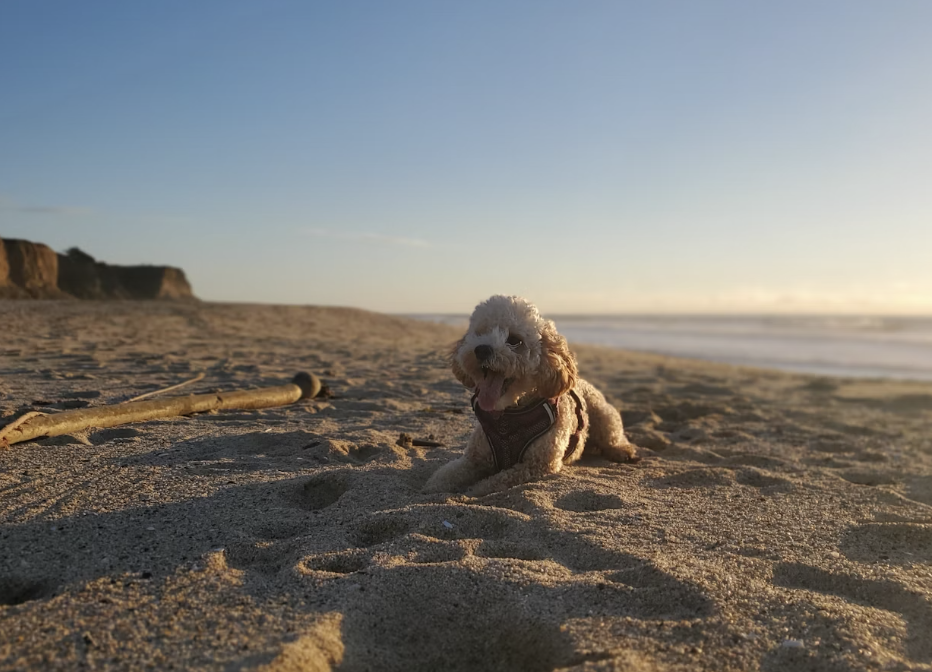
Picture thousands of exhausted birds arriving on Australian shores after an 11,000-kilometre non-stop flight from the Arctic—only to find dogs and their owners unknowingly blocking their path to survival.
It's a conservation clash that's now reached a tipping point, with councils across the country taking dramatic action to protect some of the world's most endangered travellers.
Sunshine Coast councillor Joe Natoli went so far as to say he would 'happily ban all dogs from beaches' if that’s what it takes to protect migratory shorebirds, arguing that 'the beaches and the tidal zones are the natural environment for shorebirds — it’s not the natural environment for dogs and the two just don’t mix.'
The Sunshine Coast Council has just adopted its ambitious Shorebird Conservation Plan 2025-30, joining a growing list of Australian councils implementing seasonal dog bans to protect vulnerable migratory birds.
The community can provide feedback on the draft plan, which helps determine what actions should be a priority for the council for the next five years.
The plan will recommend local law amendments between now and April, with the goal of restricting dog access where shorebirds nest and feed — aiming to reduce disturbance to nesting areas by as much as 80 per cent.
But this isn't just about one Queensland council—it's part of a nationwide movement that's dividing communities and forcing difficult choices between beloved pets and critically endangered wildlife. The migratory birds start arriving as early as August, starving and exhausted after their 11,000km flight from the Arctic
In this article
The silent crisis unfolding on our shores
About 75 percent of the world's Far Eastern Curlew population winters in Australia, making us global custodians for these remarkable birds. Yet over the last 30 years, Eastern Curlew numbers in Australia have dropped by 80 per cent - a decline so steep that the Australian Government has classified them as critically endangered under the Environment Protection and Biodiversity Conservation Act.
'Critically endangered is one step away from extinct,' Liz Gould from BirdLife Australia warned. 'If we don’t want to be contributing to that, then we need to be doing more positive actions to protect them, manage disturbance, halt habitat loss and reduce other threats.'
To put this in perspective, the species has experienced a 5.8 per cent annual rate of decline, and if this trend persists, the global population will fall to just 10 per cent of its 1993 abundance by 2035.
'Critically endangered is one step away from extinct'
These birds migrate south by day and night, usually along coastlines, leaving breeding areas from mid-July to late September. They arrive in north-western and eastern Australia mainly in August, with large numbers appearing on the east coast from September to November.
Far Eastern Curlews have already begun landing on the Sunshine Coast after their massive Arctic journey—a sight locals are hoping will continue for years to come.
Why dogs spell trouble for shorebirds
The relationship between dogs and shorebirds isn't about aggression—it's about instinct. Disturbance by recreational coastline users, such as beach walkers coming too close or birds being chased by dogs walking off leash, creates a cascade of problems for these already stressed travellers.
'Dogs may see a bird and want to play with it,' Gould said, 'but they could accidentally injure or kill it, or harm their eggs in the process.'
Even well-behaved dogs on leads can trigger what experts call a 'flight response' in birds hundreds of metres away. When disturbed, shorebirds stop vital activities like resting, feeding, and for beach-nesting species, caring for eggs and young.
[p}'Even walking a dog on a leash can be detrimental,' Gould explained. 'They’ll often see the threat coming and fly away. Even people walking on the beach with their dog hundreds of metres away can cause that same reaction—the owners probably wouldn’t even realise the impact they’ve had.'[/p]
The energy equation
Far Eastern Curlews nearly double their weight before migration begins to fuel their incredible 20,000km journey [13]. Every time they're forced to take flight unnecessarily, they burn precious energy reserves needed for survival and the return journey north.
Beach users need education on appropriate behaviour to minimise disturbance to feeding or resting Eastern Curlews [14], but many dog owners remain unaware their presence is causing harm even from considerable distances.
A national movement takes flight
The Sunshine Coast isn't pioneering this approach—it's following a growing trend across Australian coastal councils grappling with the same conservation crisis.
The seasonal ban is only the latest in a wave of local crackdowns across the country: in NSW’s Central Coast, councils and wildlife groups are flagging nesting zones for Little Terns, while in Victoria, 13th Beach has added fencing to protect Hooded Plovers.
On NSW's Central Coast, prime nesting areas for endangered Beach Stone-curlews, Pied Oystercatchers and Little Terns include beaches around Harrington and Farquhar, with council managers reporting about 60 Little Tern eggs at monitoring sites.
Sutherland Shire provides eight off-leash dog parks and beaches while making it clear dogs are prohibited in sensitive environmental areas to protect endangered wildlife. Meanwhile, Wollongong considers rock platforms as wildlife protection areas under their Dogs on Beaches policy, as they're home to shorebirds such as the endangered Pied Oystercatcher and vulnerable Sooty Oystercatcher.
The human element: Community pushback grows
Not everyone's welcoming these changes with open arms. On the Central Coast, three separate petitions protesting the council's Dogs in Open Space Plan have collectively attracted almost 3,000 signatures [19].
The concerns are deeply personal. Elderly people comprise 30 per cent of the community, and many cannot walk on sand, with grass venues their only option and dogs often their only companions. Dog owners argue their pets significantly decrease loneliness and mental health issues, making it unacceptable to restrict beach access hours [21].
The Sunshine Coast expects 81,000 dogs to call the region home by 2041, highlighting the scale of the management challenge ahead.
Finding the balance
- Sunshine Coast's draft plan proposes more than 15km of off-leash and 18km of on-leash dog access along beaches—the largest offering of any council in south-east Queensland [23]
- Seasonal restrictions apply only during critical nesting and migration periods
- Artificial habitats and floating roosts are being trialled to give birds undisturbed resting areas [24]
- Education campaigns aim to build understanding rather than just enforcement
What this means for you as a dog owner
The changes don't mean an end to beach walks with your four-legged mate—but they do require more planning and awareness.
Dog walkers should use dog-friendly beaches only and always keep dogs on a leash, unless in a designated off-leash area. Dogs must not be allowed to wander above the high-tide mark where endangered shorebirds may nest.
The key dates to remember: Migratory shorebirds arrive as early as July and spend our summer (the non-breeding period) feeding and roosting before departing around mid-April. This roughly six-month window aligns with when most restrictions will apply.
Example Scenario
- Planning your beach visit - Before heading out, check your local council's website or app for current restrictions. Look for the coloured signage system many councils use: green means go (designated off-leash areas), amber means on leash, and red means no dogs allowed. Swimming, boating, kayaking, and fishing within 100 metres of shorebirds may make them take flight and burn vital energy - the same principle applies to dog walking.
Looking ahead: A test of Australian values
This conservation effort will benefit not just migratory and resident shorebirds, but a wide range of coastal birds and ecosystems, ensuring these remarkable species remain part of our coastal landscape for generations to come [32].
Acting now gives conservation efforts time to reverse the damage before it becomes irreversible - a sobering reminder that we're witnessing what could be the final chapter for some of the world's most extraordinary travellers.
The question now isn't whether these restrictions will spread—councils across Australia are already flagging that dogs could be excluded from sand dunes and patrolled beaches - but whether communities can find the balance between human recreation and wildlife survival.
What This Means For You
For many Australian seniors who've watched their local beaches change over decades, this represents both a loss and an opportunity: the chance to be part of a conservation success story that could determine whether future generations get to witness one of nature's most spectacular migrations.
What are your thoughts on these seasonal dog restrictions? Have you noticed changes in shorebird populations at your local beach over the years? Share your experiences and opinions below—your perspective matters in this important community conversation.
Primary Source
https://au.news.yahoo.com/why-aussi...-ban-dogs-from-popular-beaches-070932207.html
Sunshine Coast Council Shorebird Plan | OurSC
Cited text: The Sunshine Coast Shorebird Conservation Plan 2025—30 has been adopted at Council’s latest meeting.
Excerpt: The Sunshine Coast Council has just adopted its ambitious Shorebird Conservation Plan 2025-30
https://oursc.com.au/environment/balanced-approach-how-new-plan-will-help-shorebirds
Sunshine Coast Council extends a wing for migrating shorebirds
Cited text: A new Sunshine Coast Shorebird Conservation Plan 2025-30 has outlined a clear strategy to reduce threats to at-risk migrating shorebirds in a bid to p...
Excerpt: The Sunshine Coast Council has just adopted its ambitious Shorebird Conservation Plan 2025-30
https://www.indailyqld.com.au/news/...eted-in-bid-to-save-sunshine-coast-shorebirds
Draft conservation plan includes closing sections of beaches
Cited text: The community can provide feedback on the draft Shorebird Conservation Plan 2025-2030, to help determine what actions should be a priority for the cou...
Excerpt: The community can provide feedback on the draft plan, which helps determine what actions should be a priority for the council for the next five years
https://www.sunshinecoastnews.com.a...on-plan-includes-closing-sections-of-beaches/
Far Eastern Curlew—BirdLife Australia
Cited text: The Far Eastern Curlew occurs only in our flyway, and about 75 percent of the world population winters in Australia, so we have a particular responsib...
Excerpt: About 75 percent of the world's Far Eastern Curlew population winters in Australia
https://birdlife.org.au/bird-profiles/far-eastern-curlew/
Eastern Curlew—DCCEEW
Cited text: Over the last 30 years, Eastern Curlew numbers in Australia have dropped by 80 per cent.
Excerpt: over the last 30 years, Eastern Curlew numbers in Australia have dropped by 80 per cent
https://www.dcceew.gov.au/environme...ned/action-plan/priority-birds/eastern-curlew
Far-eastern curlew—Curlew Action
Cited text: According to the East Asian and Australasian Flyway Partnership, Eastern curlew numbers have declined by 81 per cent in Australia over the past three decades....
Excerpt: over the last 30 years, Eastern Curlew numbers in Australia have dropped by 80 per cent
https://www.curlewaction.org/far-eastern-curlew/
Far-eastern curlew—Curlew Action
Cited text: This led the Australian Government to class the birds as critically endangered, under the Australian Environment Protection and Biodiversity Conservat...
Excerpt: the Australian Government has classified them as critically endangered under the Environment Protection and Biodiversity Conservation Act
https://www.curlewaction.org/far-eastern-curlew/
Strategic planning for the far eastern curlew
Cited text: It is listed as Endangered on the IUCN Red List and Critically Endangered under Australia’s EPBC Act.
Excerpt: the Australian Government has classified them as critically endangered under the Environment Protection and Biodiversity Conservation Act
https://www.nespthreatenedspecies.edu.au/projects/strategic-planning-for-the-far-eastern-curlew
Strategic planning for the far eastern curlew
Cited text: It has experienced one of the most acute declines of any Australian shorebird species: a 5.8 per cent annual rate of decline; if this trend persists, the glo...
Excerpt: the species has experienced a 5.8 per cent annual rate of decline, and if this trend persists, the global population will fall to just 10 per cent of its 1993 abundance by 2035
https://www.nespthreatenedspecies.edu.au/projects/strategic-planning-for-the-far-eastern-curlew
Far Eastern Curlew—BirdLife Australia
Cited text: The Far Eastern Curlew is a migratory species, moving south by day and night, usually along coastlines, leaving breeding areas from mid-July to late S...
Excerpt: These birds migrate south by day and night, usually along coastlines, leaving breeding areas from mid-July to late September.
https://birdlife.org.au/bird-profiles/far-eastern-curlew/
Eastern Curlew—DCCEEW
Cited text: Disturbance by recreational coastline users, such as beach walkers coming too close or birds being chased by dogs walking off leash.
Excerpt: Disturbance by recreational coastline users, such as beach walkers coming too close or birds being chased by dogs walking off leash
https://www.dcceew.gov.au/environme...ned/action-plan/priority-birds/eastern-curlew
Eastern Curlew—DCCEEW
Cited text: This means more people and their pet dogs unintentionally disturbing the birds.
Excerpt: Disturbance by recreational coastline users, such as beach walkers coming too close or birds being chased by dogs walking off leash
https://www.dcceew.gov.au/environme...ned/action-plan/priority-birds/eastern-curlew
Far-eastern curlew—Curlew Action
Cited text: In order to undertake such an arduous journey, the Far-Eastern Curlew nearly doubles its weight before migration begins.
Excerpt: Far Eastern Curlews nearly double their weight before migration begins to fuel their incredible 20,000km journey
https://www.curlewaction.org/far-eastern-curlew/
Eastern Curlew—DCCEEW
Cited text: Educate beach users on appropriate behaviour to minimise disturbance to feeding or resting Eastern Curlews.
Excerpt: Beach users need education on appropriate behaviour to minimise disturbance to feeding or resting Eastern Curlews
https://www.dcceew.gov.au/environme...ned/action-plan/priority-birds/eastern-curlew
Protect nesting birds on Australian beaches | Great Lakes Advocate | Forster, NSW
Cited text: Prime nesting areas for the endangered Beach Stone-curlews, Pied Oystercatchers and Little Terns include the beaches around Harrington, Farquhar/Manni...
Excerpt: On NSW's Central Coast, prime nesting areas for endangered Beach Stone-curlews, Pied Oystercatchers and Little Terns include beaches around Harrington and Farquhar, with council managers reporting about 60 Little Tern eggs at monitoring…
https://www.greatlakesadvocate.com.au/story/8847647/protect-nesting-birds-on-australian-beaches/
Protect nesting birds on Australian beaches | Great Lakes Advocate | Forster, NSW
Cited text: 'Currently our nesting season is going quite well, with the majority of Pied Oyster Catchers having successfully fledged,' MidCoast Council natural sy...
Excerpt: On NSW's Central Coast, prime nesting areas for endangered Beach Stone-curlews, Pied Oystercatchers and Little Terns include beaches around Harrington and Farquhar, with council managers reporting about 60 Little Tern eggs at monitoring…
https://www.greatlakesadvocate.com.au/story/8847647/protect-nesting-birds-on-australian-beaches/
Migratory and Resident Shorebirds | Sutherland Shire Council
Cited text: We have eight off-leash dog parks and beaches in Sutherland Shire. We also make it clear dogs are prohibited in sensitive environmental areas to prote...
Excerpt: Sutherland Shire provides eight off-leash dog parks and beaches while making it clear dogs are prohibited in sensitive environmental areas to protect endangered wildlife
https://www.sutherlandshire.nsw.gov...ve-wildlife/migratory-and-resident-shorebirds
Dog Beaches and Parks | City of Wollongong
Cited text: Rock platforms are considered wildlife protection areas under our Dogs on Beaches and Parks Policy PDF, 48909 KB. They're home to a range of marine li...
Excerpt: Meanwhile, Wollongong considers rock platforms as wildlife protection areas under their Dogs on Beaches policy, as they're home to shorebirds such as the endangered Pied Oystercatcher and vulnerable Sooty Oystercatcher
https://wollongong.nsw.gov.au/places/dog-beaches-and-parks
Three community petitions oppose Dogs in Open Spaces Plan—Central Coast News
Cited text: With submissions on Central Coast Council’s Dogs in Open Space Plan 2022-23 draft policy set to close in just a week, on August 26, three separate pet...
Excerpt: On the Central Coast, three separate petitions protesting the council's Dogs in Open Space Plan have collectively attracted almost 3,000 signatures
https://coastcommunitynews.com.au/c...ty-petitions-oppose-dogs-in-open-spaces-plan/
Three community petitions oppose Dogs in Open Spaces Plan—Central Coast News
Cited text: She said elderly people comprise 30 per cent of the community and many cannot walk on sand, with grass venues their only option and dogs often their o...
Excerpt: Elderly people comprise 30 per cent of the community, and many cannot walk on sand, with grass venues their only option and dogs often their only companions
https://coastcommunitynews.com.au/c...ty-petitions-oppose-dogs-in-open-spaces-plan/
Three community petitions oppose Dogs in Open Spaces Plan—Central Coast News
Cited text: Dogs are often the best friend of an owner, they significantly decrease loneliness and mental health issues. It is unacceptable to ask owners to restr...
Excerpt: Dog owners argue their pets significantly decrease loneliness and mental health issues, making it unacceptable to restrict beach access hours
https://coastcommunitynews.com.au/c...ty-petitions-oppose-dogs-in-open-spaces-plan/
Ruff deal? More parks but less beach proposed for dogs
Cited text: The draft Dog Exercise Area Plan and Network Blueprint has been released for community feedback, with 81,000 pooches expected to call the region home ...
Excerpt: The Sunshine Coast expects 81,000 dogs to call the region home by 2041
https://www.sunshinecoastnews.com.a...ogs-includes-more-parks-but-less-beach-space/
dog, enviroment | Sunshine Coast Council
Cited text: “Our draft plan proposes more than 15km of off-leash and 18km of on-leash dog access along our beaches and foreshores—the largest offering of any coun...
Excerpt: Sunshine Coast's draft plan proposes more than 15km of off-leash and 18km of on-leash dog access along beaches—the largest offering of any council in south-east Queensland
https://www.sunshinecoast.qld.gov.a...g-environmental-needs-and-dog-friendly-spaces
Sunshine Coast Council extends a wing for migrating shorebirds
Cited text: Artificial habitats and floating roosts would also be trialled to allow for migratory shorebirds to rest undisturbed.
Excerpt: Artificial habitats and floating roosts are being trialled to give birds undisturbed resting areas
https://www.indailyqld.com.au/news/...eted-in-bid-to-save-sunshine-coast-shorebirds
Protect nesting birds on Australian beaches | Great Lakes Advocate | Forster, NSW
Cited text: Walk your dogs on dog-friendly beaches only and always keep them on a leash, unless you're in a designated off-leash area.
Excerpt: Dog walkers should use dog-friendly beaches only and always keep dogs on a leash, unless in a designated off-leash area
https://www.greatlakesadvocate.com.au/story/8847647/protect-nesting-birds-on-australian-beaches/
Protect nesting birds on Australian beaches | Great Lakes Advocate | Forster, NSW
Cited text: Walk your dogs on dog-friendly beaches only and always keep them on a leash, unless you're in a designated off-leash area.
Excerpt: Dog walkers should use dog-friendly beaches only and always keep dogs on a leash, unless in a designated off-leash area
https://www.greatlakesadvocate.com.au/story/8847647/protect-nesting-birds-on-australian-beaches/
Protect nesting birds on Australian beaches | Great Lakes Advocate | Forster, NSW
Cited text: This means a dog must not be allowed to wander above the high-tide mark where endangered shorebirds may nest.
Excerpt: Dogs must not be allowed to wander above the high-tide mark where endangered shorebirds may nest
https://www.greatlakesadvocate.com.au/story/8847647/protect-nesting-birds-on-australian-beaches/
Migratory and Resident Shorebirds | Sutherland Shire Council
Cited text: ... Migratory shorebirds arrive on our shores as early as July, exhausted from their long flight from breeding grounds in the Northern Hemisphere (e.g...
Excerpt: Migratory shorebirds arrive as early as July and spend our summer (the non-breeding period) feeding and roosting before departing around mid-April
https://www.sutherlandshire.nsw.gov...ve-wildlife/migratory-and-resident-shorebirds
Migratory and Resident Shorebirds | Sutherland Shire Council
Cited text: They will spend the non-breeding period (our summer) feeding and roosting before setting off around mid-April to return to breeding grounds in the Nor...
Excerpt: Migratory shorebirds arrive as early as July and spend our summer (the non-breeding period) feeding and roosting before departing around mid-April
https://www.sutherlandshire.nsw.gov...ve-wildlife/migratory-and-resident-shorebirds
Full List of Dog-Friendly Beaches on the Central Coast—Coasties Mag
Cited text: Keep an eye out for the coloured signs: green means go (designated off-leash areas), amber means on leash, and red means no dogs allowed.
Excerpt: green means go (designated off-leash areas), amber means on leash, and red means no dogs allowed
https://coastiesmag.com.au/full-list-of-every-central-coast-dog-beach/
Migratory and Resident Shorebirds | Sutherland Shire Council
Cited text: Swimming, boating, kayaking, and fishing within 100 metres of shorebirds may make them take flight and burn vital energy.
Excerpt: Swimming, boating, kayaking, and fishing within 100 metres of shorebirds may make them take flight and burn vital energy
https://www.sutherlandshire.nsw.gov...ve-wildlife/migratory-and-resident-shorebirds
Sunshine Coast Council extends a wing for migrating shorebirds
Cited text: “This is about more than migratory and resident shorebirds—its outcomes will benefit a wide range of coastal birds and ecosystems, ensuring these re...
Excerpt: This conservation effort will benefit not just migratory and resident shorebirds, but a wide range of coastal birds and ecosystems, ensuring these remarkable species remain part of our coastal landscape for generations to come
https://www.indailyqld.com.au/news/...eted-in-bid-to-save-sunshine-coast-shorebirds
Sunshine Coast Council extends a wing for migrating shorebirds
Cited text: “Acting now gives conservation efforts time to reverse the damage before it is irreversible.” ... Critical minerals are having a moment.
Excerpt: Acting now gives conservation efforts time to reverse the damage before it becomes irreversible
https://www.indailyqld.com.au/news/...eted-in-bid-to-save-sunshine-coast-shorebirds
Dogs in public spaces: everything you wanted to know about Council’s draft policy
Cited text: ... Central Coast Council is flagging that dogs could be excluded from all sand dunes and patrolled beaches and that access to beach off leash areas c...
Excerpt: councils across Australia are already flagging that dogs could be excluded from sand dunes and patrolled beaches
https://www.cccouncilwatch.com.au/d...u-wanted-to-know-about-councils-draft-policy/







